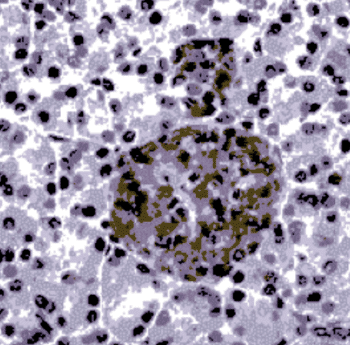Blood Test Predicts Diabetes Mellitus Type 1 Risk
By LabMedica International staff writers
Posted on 04 Jul 2013
Type 1 diabetes usually has a preclinical phase identified by circulating islet autoantibodies, but the rate of progression to diabetes after seroconversion to islet autoantibodies is equivocal.Posted on 04 Jul 2013
Diabetes mellitus type 1 can occur at any age and it starts with the immune system destroying insulin-producing beta cells, which eventually stops the production of insulin and without insulin the body cannot control blood sugar or glucose.

Image: Human pancreas stained with anti-glutamic acid decarboxylase 65 antibody (Photo courtesy of Mybiosource).
Scientists based at the Helmholtz Zentrum (Munich, Germany) gathered data from three different studies, which included a total of 13,377 children. The study involved analyzing blood samples taken from children to identify any preclinical clues that indicate any increased risk of type 1 diabetes. Two diabetes-related autoantibodies were found to be the strongest indicators of diabetes risk.
The children’s genetic risk for type 1 diabetes was estimated by measuring the development of insulin autoantibodies, glutamic acid decarboxylase 65 (GAD65) autoantibodies, and insulinoma antigen 2 (IA2) autoantibodies. At the 10-year follow-up, an overwhelming 70% of the children with multiple islet autoantibodies developed type 1 diabetes, compared to 15% among those with just one autoantibody.
At follow-up, 8% of the children had one or more of the autoantibodies, indicators for the destruction of insulin, 585 children had at least two autoantibodies and 474 were found to have just one. Nearly half of the children with two or more autoantibodies went on to develop diabetes within five years, and four out of every five of them became diabetic within fifteen years. Only 14.5% of children with just one autoantibody developed type 1 diabetes after 10 years.
The authors concluded that the detection of multiple islet autoantibodies in children who are genetically at risk marks a preclinical stage of type 1 diabetes. Thus, the development of multiple islet autoantibodies in children predicts type 1 diabetes. Future prevention studies should focus on this high-risk population.
"Jay S. Skyler, MD, and Jay M. Sosenko, MD, both from the Leonard M. Miller School of Medicine (Miami, FL, USA) wrote in an accompanying editorial: "If you have two or more autoantibodies, it's nearly inevitable that you will develop the disease. Most people, even physicians, don't appreciate this risk." The study was published on June 19, 2013, in the Journal of the American Medical Association.
Related Links:
Helmholtz Zentrum
Leonard M. Miller School of Medicine













